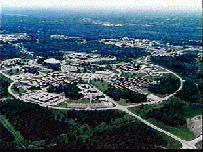 |
About Argonne |
Welcome
About Argonne
Accomplishments
Research Programs
Research Divisions
Research Facilities
Publications
User Registration
Educational Programs
Distinguished
Fellows
Working with Argonne
Technology Transfer
Technical Services
Procurement
Find Argonne People
Contact Us
Argonne Alumni
A-Z Index
America's first national laboratoryArgonne National Laboratory is one of the U.S. Department of Energy's largest research centers. It is also the nation's first national laboratory, chartered in 1946. Recognized for its excellence in connecting basic research to innovative technology, Argonne is a direct descendant of the University of Chicago's Metallurgical Laboratory, part of the World War Two Manhattan Project. It was at the Met Lab where, on Dec. 2, 1942, Enrico Fermi and his band of about 50 colleagues created the world's first controlled nuclear chain reaction in a racquets court at the University of Chicago. Fermi believed that a collaborative approach to science would deepen understanding and result in greater value. Over the years, Argonne has embraced Fermi's beliefs, creating one of the world's broadest scientific institutes, bringing together many areas of science, engineering and technology. Today, the laboratory has about 2,800 employees, including about 1,000 scientists and engineers, of whom about 750 hold doctorate degrees. Argonne's annual operating budget of about $530 million supports upwards of 200 research projects, ranging from studies of the atomic nucleus to global climate change research. Since 1990, Argonne has worked with more than 600 companies and numerous federal agencies and other organizations. Argonne occupies 1,500 wooded acres in DuPage County, Ill. The site is surrounded by forest preserve about 25 miles southwest of Chicago's Loop. The site also houses the U.S. Department of Energy's Chicago Operations Office. Commitment to safetyArgonne is dedicated to safety in all our activities. Every employee, visitor, facility user and research collaborator is expected to put safety above all other concerns. No job is important enough to compromise the safety of our employees, guests or neighbors. Research programsArgonne research falls into five broad categories: • Basic science seeks solutions to a wide variety of scientific challenges. This includes experimental and theoretical work in materials science, physics, chemistry, biology, high-energy physics, and mathematics and computer science, including high-performance computing. This kind of basic research brings value to society today by helping lay the foundation for tomorrow's technological breakthroughs. • Scientific facilities like Argonne's Advanced Photon Source help advance America's scientific leadership and prepare the nation for the future. The laboratory designs, builds and operates sophisticated research facilities that would be too expensive for a single company or university to build and operate. They are used by scientists from Argonne, industry, academia and other national laboratories, and often by scientists from other nations. The laboratory is also home to the Intense Pulsed Neutron Source, the Argonne Tandem Linear Accelerator System and other facilities. • Energy resources programs help insure a reliable supply of efficient and clean energy for the future. Argonne scientists and engineers are developing advanced technologies and systems for a number of energy applications, including nuclear reactors, batteries and fuel cells, transportation, and electric power generation and storage. • Environmental management includes work on managing and solving the nation's environmental problems and promoting environmental stewardship. Research in this area includes alternative energy systems; environmental risk and economic impact assessments; hazardous waste site analysis and remediation planning; electrometallurgical treatment to prepare spent nuclear fuel for disposal; and new technologies for decontaminating and decommissioning aging nuclear reactors. • National Security has increased in significance in recent years for the nation and for Argonne research. Argonne capabilities developed over the years for other purposes are helping counter the threats of terrorism. These capabilities include expertise in the nuclear fuel cycle, biology, chemistry, and systems analysis and modeling. This research is helping develop highly sensitive instruments and technologies to detect chemical, biological and radioactive threats and identify their sources. Other research is helping to detect and deter possible weapons proliferation or actual attacks. Industrial technology development is an important activity in moving benefits of Argonne's publicly funded research to industry to help strengthen the nation's technology base. Argonne's Division of Educational Programs provides a wide range of educational opportunities for faculty and students ranging from leading national universities to local junior high schools. More people attend educational programs at Argonne than at any other DOE national laboratory. Argonne is a U.S. Department of Energy laboratory managed by UChicago Argonne, LLC. |
|
|||||
|
||||
 Argonne National Laboratory occupies 1,500 wooded acres in DuPage County,
Ill, about 25 miles southwest of Chicago.
Argonne National Laboratory occupies 1,500 wooded acres in DuPage County,
Ill, about 25 miles southwest of Chicago.